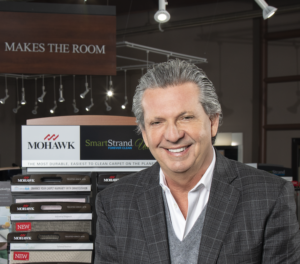The flooring industry is expected to see marginal growth in 2025—perhaps up low single digits—with gradual improvement expected as the year progresses, especially if interest/mortgage rates settle down. That’s the consensus among several leading executives who point to stubbornly high mortgage rates with keeping a lid on the housing market, in particular remodeling and new construction.
For 2025, mortgage rates remain a major wild card. Currently hovering just under 7% for a 30-year fixed conventional loan, flooring executives say that percentage needs to dip below 6%—at the very least—to begin to trigger the pent-up demand that the industry is so thirsting for.
 Tim Baucom, president/CEO, Shaw Industries
Tim Baucom, president/CEO, Shaw Industries
For 2025, I’m optimistic about the flooring industry overall. After several challenging years, we believe the market bottomed out in late 2024 and is now poised for modest growth. Industry demand is expected to outpace GDP growth, with strength building in the second half of the year as economic pressures like mortgage rates and inflation ease.
Drivers include pent-up demand for housing, a surge in renovation activity due to aging housing stock and increasing investment in commercial spaces like healthcare, education and hospitality.
The challenges for our industry in 2025 revolve around affordability and accessibility. Housing affordability continues to limit home purchases and household formation, which affects demand for flooring. Economic uncertainty, including high interest rates and inflation, is slowing discretionary spending. On top of that, the ongoing labor shortages, particularly among installers, create barriers to meeting demand efficiently.
Policy shifts, such as potential new tariffs, could add another layer of complexity such as introducing cost pressures and requiring adjustments to sourcing strategies.
Challenges often pave the way for opportunity. In residential flooring, the aging housing stock in the U.S., coupled with improving access to equity, creates significant potential for remodel-driven growth. We’re also seeing strong consumer demand for personalization, such as custom-sized rugs, patterned carpets and sustainable solutions tailored to evolving lifestyles.
At Shaw, we’re confident in our ability to grow ahead of the market. During the downturn, we made strategic investments and changes that position us to lead. Shaw’s 2025 strategy is built on innovation, investment and partnership. One of our most exciting initiatives is the continued expansion of our manufacturing capacity, including doubling production at our resilient flooring manufacturing facility in Ringgold, Ga., and realizing the benefits of the $500 million investment in fiber production at our Aiken, S.C. facility. These advancements allow us to stay agile and responsive to customer needs.
In commercial markets, sectors like healthcare, education and hospitality are investing in creating better physical environments, and Shaw is at the forefront with innovative solutions. The demand for environmentally conscious and design-forward solutions gives us a clear path to lead the industry.
On the product side, we’re elevating the market with innovations like EcoWorx Resilient, which has already received widespread recognition for its sustainability and design flexibility in commercial applications. For residential, we’re growing offerings like Pet Perfect and expanding our luxury resilient portfolio to meet the demand for pet-friendly, durable and easy-to-maintain solutions.
Finally, our customer-focused approach remains central. Through partnerships with designers, trade professionals and retail partners, we’re working to provide tailored solutions that align with local market needs.
 Brian Carson, CEO, AHF Products
Brian Carson, CEO, AHF Products
The Fed lowering interest rates so far has not made much of a dent in mortgage rates. Additional cuts will be needed to push rates down.
The way things stand, interest rates are still high enough that the affordability to buy a new home is not there. There are trillions and trillions of dollars tied up in home equity. But in order to tap into that equity, you still need a home equity line of credit (HELOC). The loan you take out is just out of sight right now; so, mortgage rates have to come down but so, too, do HELOC rates.
Looking ahead, the opportunities are there. Homes are getting older and in need of remodel; there are not enough single- and muti-family residences to keep up with the population. We are under built, just waiting for the right environment to get better. Once it starts cranking, we will have years of sustained growth, with the market primed for a five- to six-year run. I see somewhere around midway 2025 as the tipping point where people will start leaning in.
As for challenges, I do think tariffs are going to be an issue. We will see higher freight costs, higher prices in the cost of the product. Unlike the last time when Trump was in office, the [expected] tariffs will not be limited to China. This time tariffs most likely will go on many products and many countries, with a higher percentage on China.
AHF Products, however, is in a uniquely wonderful position. We have one plant in Asia (Cambodia). We have 12 hard surface factories in the U.S.—porcelain, vinyl, engineered hardwood, solid hardwood, commercial and residential—no one else has that. We also invested $35 million in the factories. Many companies hit the pause button in 2024. We did not. We’ve added capacity and new product capability; we’ve continued with these investments. We’re sitting in a wonderful position manufacturing product here in the U.S. I do think customers will be lining up for U.S. capacity—to get their nose at the trough faster.
We at AHF are very fortunate, and I think it will turn out to be a good thing that we had the wherewithal to continue to build out factories and to acquire two more.
 Jeff Meadows, president of residential sales, Mohawk
Jeff Meadows, president of residential sales, Mohawk
We see 2025 being marginally better than 2024, from flat to 2% higher on the upside. It has the potential to be a better year, but you talk to a lot of people and there’s the sense that the first half may be like it has been, with maybe a better outlook for the second half.
The biggest challenge for the flooring industry is existing-home sales, which is much more a driver of business than new single-family home sales. When you have existing-home sales you have the sellers going in and doing a couple of rooms and the buyers coming in and doing a couple of rooms. It’s good for the flooring business.
We have to get the [mortgage] rates under 6%. People won’t trade a 4% mortgage for a 7% mortgage: they’re not going to move. If we can get that rate down—we won’t see 3%—we will get some activity going. So, existing-home sales is key.
There is a good amount of pent-up demand for people who are not moving; 40% of the homes are over 45 years old; so, there is pent-up demand where people will spend money again.
Another important statistic: 40% of people have no mortgage; however, home equity loans have been 10%, 11% and 12%; people don’t want to take out those loans at that percentage rate; so that’s another opportunity [if rates can come down].
The flooring industry has been in a recession for two years. We had a sugar high in 2021 and 2022 (from a COVID-19-related boost in business), but the industry has been down 9%, 10% in back-to-back years.
When you look at opportunities, you ask, “What can I do to take market share?” Our mindset is figuring out areas where we can take market share, whether hard surface or soft surface. That is going to be our opportunity until things turn around.
We have spent a lot of money the last four years on domestic production for hard surface, adding millions of feet of hard surface capacity. If tariffs come into play, it will hurt others worse than us. We do import as well, but we have added all that capacity.
 Raj Shah, co-CEO, MSI
Raj Shah, co-CEO, MSI
After two years of the flooring industry working through the pandemic hangover, which included deflation, destocking and high interest rates, we believe that a rebound is due in 2025.
We don’t believe that this will be a hockey stick growth but rather slower growth in 2025. Although inflation is starting to get to the Fed’s targeted rate, long-term interest/mortgage rates remain stubbornly high. This will continue to be a headwind into 2025 for remodeling and new construction.
On the positive side all demographic data shows the country is due for significant growth in construction. This is due to an aging housing stock, not enough homes for the population and the ongoing change in trends. In addition, there are many opportunities and challenges that may come up with the new administration. As an industry we will see how this plays out over the next few months.
Looking ahead, there are a few challenges. Some are within our control and some we need to work through:
- Interest/mortgage rates: This has slowed down overall growth for the flooring industry the past two years and will remain an issue for most of 2025.
- Labor: Labor continues to be a limiting factor in the total cost of flooring. This is related to both availability and cost. There is no silver bullet to this issue. In addition, with immigration reform being a top priority this will continue to put pressure on labor availability and costs.
- Regulation: This continues to add volatility and costs to the industry. Whether it is UFLPA, environmental regulations, tariffs, PFAS, labor regulations, etc. All of this is top of mind for the industry and ultimately a challenge/obstacle that we need to work through.
At the same time, there is so much opportunity. There is a huge backlog of remodeling and a large requirement for new homes across the country. The best way the industry will be able to monetize this opportunity is to provide more inspiration and make it easier for consumers to have the floor of their dreams. As an industry if we can make it easier there will be huge dividends. This is related to providing inspiration, helping understand the pros and cons of each product, helping find retailers and then making the installation quick and lower priced.
 Tom Pendley, president/CEO, Mannington Mills
Tom Pendley, president/CEO, Mannington Mills
We are expecting the industry to be up low single digits in 2025, with most of that increase coming in the second half of the year. This is very similar to our assumptions as we entered 2024.
The cost of home ownership will continue to challenge the overall residential market, but the fundamentals of the housing market will stabilize the downside. We are short on housing. As for most, if not all, of the rest of the industry, we expect to outperform the market in 2025.
However, the industry faces many challenges. On the residential side, the cost of home ownership makes it difficult for first-time homebuyers to enter the market. The lock-in effect of very low interest rates continues to put significant pressure on existing-home sales. On the commercial side, work from home policies continue to lead to higher commercial vacancy rates.
With the challenges above, there are still always opportunities. New construction will occur. Families will move. Businesses will expand. The opportunity is to focus on customers, understand their needs and be prepared to meet those needs.
As for Mannington, we have been focused on business simplification, execution excellence and product innovation. This theme will continue as we focus on the customer experience.
(For the full executive forecast, which includes each flooring category, see the Dec. 9 issue of FCNews.)
The post Executive Forecast 2025: Gradual progress despite high interest rates appeared first on Floor Covering News.
